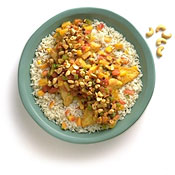|
|
Cuisine Glossary
| You have reached our International Cuisines and information on all aspects of a countries cuisine.
We will try to explain the culture, significant influences, climate, and other factors that have come together to create a distinct style. For example: Spanish, Mexican or Japanese. |
Caribbean Cuisine
 |
A few decades ago, the Caribbean people thought their food not good enough for the annual hoards of vacationing tourists. They considered their local dishes too native and uninteresting, and chose to offer visitors French food instead. Fortunately, after constant demand, Caribbean hoteliers and restaurateurs now offer a variety of traditional foods throughout the islands.
From the lush tropical vegetation of the Caribbean comes an astonishing array of fruit. There are coconuts, pineapples, passion fruits, papayas, mangoes, apples, oranges, bananas, melons, figs, pomegranate, and limes. Others include the breadfruit, ugli, naseberry, tamarind, sapodilla, soursop, plantains, cherimoya, monstera, loquat, carambola, guava, and mamey sapote. Some exotic fruits are not exported because they are too delicate, which is why many Caribbean fruits are unfamiliar to those who do not travel to the Islands. Some fruits are enjoyed right off the trees as part of a meal or snack, but many are used for a variety of both sweet and savory dishes. Mangos and papayas are used in drinks, desserts like sherbets and mousse, and in fiery chutneys. Coconuts are used for coconut bread, coconut ice cream, flan, and that world-famous Pina Colada. Coconut milk is also used for meat sauces, and even cooked with beans. Plantains, which are similar to bananas, are eaten grilled, fried, prepared as crispy chips, or baked in meat pies. Vegetables, likewise, are prolific on the islands. Yams, pumpkin, yuca, calabaza, callaloo, chayote, sweet potatoes, okra, tomatoes, zucchini, cucumbers, and bell peppers are all used to their full advantage. A variety of legumes are also popular, especially black beans used in popular Cuban black bean soup. Other common beans are pigeon peas, black-eyed peas, and red beans. Most bean dishes are served with rice and cornbread, similar to Creole menus of the Southern U.S. Poultry dishes are widespread throughout the Caribbean, mostly because chicken is the most economical meat. It is often marinated with ginger, lime, and chilies before grilling. Beef and pork dishes are common in Caribbean cuisine, but more so on the Spanish Islands. Goat, and less popular lamb, are used on some islands. Curried Goat is a holiday specialty of Jamaica. Treasures from the sea are another reason to experience Caribbean cuisine. These are the fresh fish, shellfish, and other tropical delicacies caught daily in the warm waters of the Caribbean Sea. Hundreds of varieties of fish are available, including sea bass, swordfish, pompano, mullet, kingfish, yellowtail, tuna, wahoo, snapper, grouper, mackerel, and dolphin fish. They are grilled, baked, or served in chowders and stews. Salt codfish is a Caribbean specialty. Its most common presentations are in salads and stews, or with scrambled eggs. Shellfish like the spiny lobster and shrimp are ubiquitous, and both given the special Caribbean touch with specialties like Lobster Creole and Coconut Shrimp. Other Carribean specialties include conch, sea urchin, and turtle. Probably because of the preponderance of sugar cane in the islands, desserts are an important part of a Caribbean meal. They come in every form, from cakes, dumplings, bread and rice puddings, to flan, souffle and mousse. There are also frozen ices and sherbets. Many desserts utilize local fresh and dried fruits, sometimes sweet potatoes, pumpkin, and avocado; rum is sometimes an ingredient. By no means are all Caribbean dishes fiery hot and spicy, but chilies are the most widespread form of Caribbean seasoning. It is not unusual when dining in the islands, that a bottle of local hot sauce be available to patrons. Source: HungryMonster Writers |




